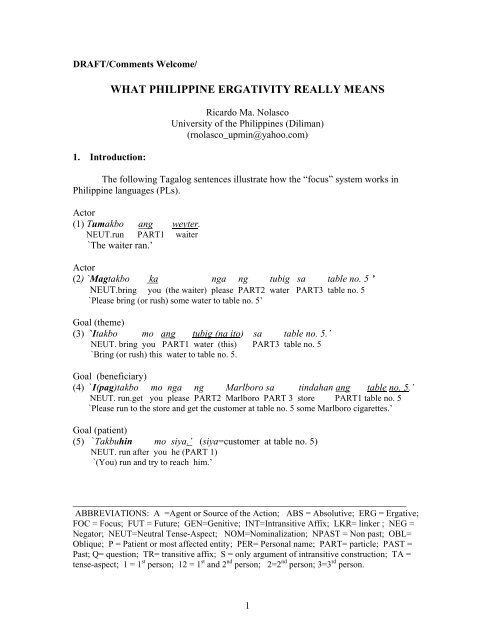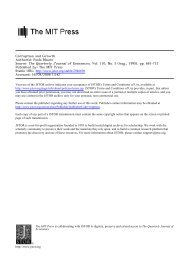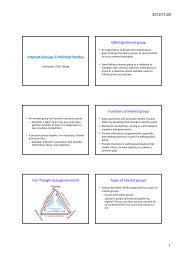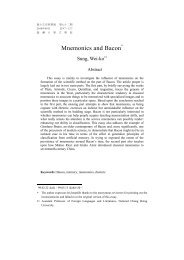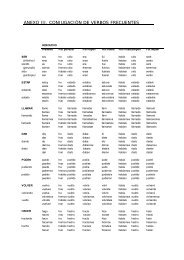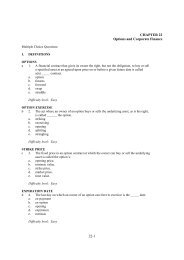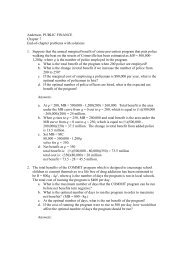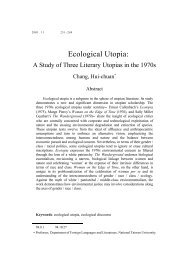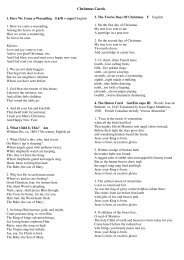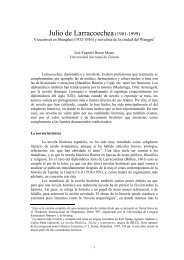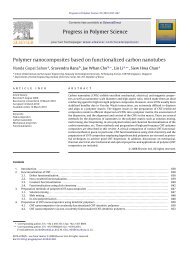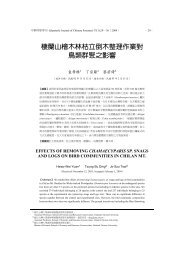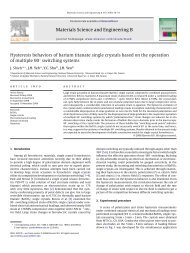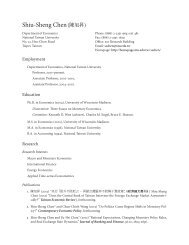WHAT PHILIPPINE ERGATIVITY REALLY MEANS
WHAT PHILIPPINE ERGATIVITY REALLY MEANS
WHAT PHILIPPINE ERGATIVITY REALLY MEANS
Create successful ePaper yourself
Turn your PDF publications into a flip-book with our unique Google optimized e-Paper software.
DRAFT/Comments Welcome/<br />
1. Introduction:<br />
<strong>WHAT</strong> <strong>PHILIPPINE</strong> <strong>ERGATIVITY</strong> <strong>REALLY</strong> <strong>MEANS</strong><br />
Ricardo Ma. Nolasco<br />
University of the Philippines (Diliman)<br />
(rnolasco_upmin@yahoo.com)<br />
The following Tagalog sentences illustrate how the “focus” system works in<br />
Philippine languages (PLs).<br />
Actor<br />
(1) Tumakbo ang weyter.<br />
NEUT.run PART1 waiter<br />
`The waiter ran.’<br />
Actor<br />
(2) `Magtakbo ka nga ng tubig sa table no. 5 ’<br />
NEUT.bring you (the waiter) please PART2 water PART3 table no. 5<br />
`Please bring (or rush) some water to table no. 5’<br />
Goal (theme)<br />
(3) `Itakbo mo ang tubig (na ito) sa table no. 5.’<br />
NEUT. bring you PART1 water (this) PART3 table no. 5<br />
`Bring (or rush) this water to table no. 5.<br />
Goal (beneficiary)<br />
(4) `I(pag)takbo mo nga ng Marlboro sa tindahan ang table no. 5.’<br />
NEUT. run.get you please PART2 Marlboro PART 3 store PART1 table no. 5<br />
`Please run to the store and get the customer at table no. 5 some Marlboro cigarettes.’<br />
Goal (patient)<br />
(5) `Takbuhin mo siya.’ (siya=customer at table no. 5)<br />
NEUT. run after you he (PART 1)<br />
`(You) run and try to reach him.’<br />
___________________________________________________________________________<br />
ABBREVIATIONS: A =Agent or Source of the Action; ABS = Absolutive; ERG = Ergative;<br />
FOC = Focus; FUT = Future; GEN=Genitive; INT=Intransitive Affix; LKR= linker ; NEG =<br />
Negator; NEUT=Neutral Tense-Aspect; NOM=Nominalization; NPAST = Non past; OBL=<br />
Oblique; P = Patient or most affected entity; PER= Personal name; PART= particle; PAST =<br />
Past; Q= question; TR= transitive affix; S = only argument of intransitive construction; TA =<br />
tense-aspect; 1 = 1 st person; 12 = 1 st and 2 nd person; 2=2 nd person; 3=3 rd person.<br />
1
Goal (direction or location)<br />
(6) Tinakbuhan ka ng table no. 5.<br />
PAST. run away from you (the waiter) PART2 table no. 5<br />
`Table No. 5 ran away from you without paying the bill.’<br />
Goal (instrument)<br />
(7) Ipinangtakbo niya sa maraton ang aking Reebok.<br />
PAST. used for running he PART3 marathon PART1 my Reebok shoes<br />
`He used my Reebok shoes for running in the marathon.’<br />
The received view is that the so-called “focus” affixes (bold faced) identify the<br />
semantic relation (sentence headings) of the `focused item’ (underscored) in the<br />
sentences above.<br />
2. How has Philippine morphosyntax been analyzed?<br />
Philippine languages have been analyzed to be:<br />
a) Nominative-accusative<br />
• Active-passive dichotomy: all “goal-focus” constructions are passives derived<br />
from active.<br />
• “ang” marked entity is “subject” or “what is being talked about.”<br />
b) Ergative-absolutive<br />
• “goal” constructions are basic.<br />
• “agent” marked by ergative case (PART2), “patient” marked by absolutive<br />
(PART1)<br />
• no. 2 is “antipassive”<br />
c) Neither nominative nor ergative, but belong to a separate language type<br />
• “actor focus” construction (no.2) and “goal focus” constructions are all transitive.<br />
• “ang” marked entity is “topic.”<br />
Commonalities in previous analysis (but not all) :<br />
• The main function of the “focus” affix is to identify the semantic role of the<br />
“focused” element.<br />
• “Ang” marks the privileged syntactic argument.<br />
3. Goals of the study<br />
In this presentation, I will concur with the characterization that the grammatical<br />
patterns in pragmatically simple sentences in PLs are ergative. To me, the question of<br />
language type crucially depends on what constitutes a transitive construction in PLs. In<br />
identifying a transitive from an intransitive construction, I will invoke a set of<br />
parameters similar to those laid down by Hopper and Thompson (1980), but I have made<br />
2
some adjustments to the parameters to suit the Philippine condition. Evidence will be<br />
presented from several PLs illustrating how speakers use this set of parameters in<br />
assigning case to arguments and in choosing a particular voice form. In sum, I point to<br />
the robust manifestation of the ergative-absolutive relation in PLs and affirm in substance<br />
the findings in Mithun 1994 for Kapampangan.<br />
4. Data:<br />
The data used in this study were taken from:<br />
a) Stories in Bannawag, an Ilokano weekly magazine, namely<br />
Kaputotan ni Anteb (KA), Dec. 31, 2001, by Rodrigo Manongdo;<br />
Kartib (KAR), Feb. 19, 2001, by Emidio R. Rosal;<br />
Lakay Igme Maysa nga Ama (LIMA) by Manuel Benosa;<br />
Taraddek (TAR), March 15, 199, by Robert A. Fernandez;<br />
Ti Aningaas (TA), February 19, 2001, by Jovito F. Amorin;<br />
Ti Dalagan (TD), Dec. 24, 2001, by Delfin P. Dumayas;<br />
Umaykan Ponso, di ka Agbabati (UPDKA), April 22, 2002, by Juan S.P Hidalgo, Jr.;<br />
b) Cebuano Folktales 1, San Carlos Publications, Cebu City and the following stories in<br />
Bisaya, a Cebuano weekly magazine, namely:<br />
Ang Inyong Sexpert (AIS), Dec. 13, 2000, by Greg Laconsay<br />
Kadaogan sa Gugma (KG), Aug. 5, 1998, by Edgar S. Godin;<br />
Dahlia (DAH), May 13, 1998, by Dodds Giagonia;<br />
Pinaskuhan ni Marilou (PM), Dec. 29, 1993, by Loreto Sardovia;<br />
Ugang Dugo sa Kamot ni Manoling (UDKM), Dec. 13, 2000, Edgar Godin;<br />
c) Three (3) Tagalog romance novels:<br />
Kung Kulang pa ang Lahat (KKPAL), 1996, by Veronica Siasoco<br />
Puto at Dinuguan (PD), 1994, by Edgar Reyes;<br />
Tukso ba ang Umibig (TBAU), 1982, by Gilda Olvidado<br />
d) Donya Dulimanan kan Prinsipe Agtanang (DDPA), an Itneg narrative by Jane P.<br />
Martinez;<br />
e) Mga Sugilon no Minanubo (MSM), a collection of Agusanon stories by Teofila Bada;<br />
f) A Manuvuq oral narrative by Mercedes Allan;<br />
g) A Blaan oral narrative by Isidro Pandan;<br />
h) Two taped conversations with Narding Solomon and Babes Jetajobe of Sorsogon,<br />
Sorsogon.<br />
3
5. Definition of transitivity, case and voice in PLs:<br />
Transitivity may be defined in terms of the conceptual statuses of `source of<br />
action’ and `most affected entity’, partly following Klaiman (1988).<br />
a) A transitive construction is one where the source of action (A) is viewed as distinct<br />
from the most affected entity (P). An intransitive construction is one where the source of<br />
the action is also viewed as the most affected entity. When the A and the P refer to the<br />
same entity, it may also be labeled the S.<br />
b) Case, as used in this study, pertains to how the arguments of a predicate are formally<br />
encoded to distinguish between S, A, P and obliques. S, A, and P may be referred to as<br />
the core cases, while any other argument which is not an A, an S or a P is an oblique.<br />
c) Voice as used in this study, refers to the alternations in verbal morphology which<br />
encode the distinction in viewing how the action’s effects accrue to the clausal elements.<br />
d) In this study, voice is derivational, while tense-aspect (TA) is inflectional. But it is<br />
sometimes hard to tease apart TA from voice (see example no. 1). Almost all verbs<br />
(except root verbs) can be inflected for TA. The prototypical Tagalog verb has at least<br />
four members in its TA paradigm: “past (begun), present (begun and continuing), future<br />
(not begun) and nonfinite (neutral). There will be no further discussion of TA in this<br />
paper.<br />
Table 1. Sarangani Manobo Personal Pronouns<br />
Personal Person Set 1 Set II Set III Set IV<br />
Pronouns<br />
Singular 1 a ku kanak siak<br />
(Minimal) 12 ki ta kenita siaken<br />
2 ka ta kemno sikemno<br />
3 0 din kandin sikandin<br />
Plural 1 kay day kenami sikami<br />
(Maximal) 12 kidon tadon kenitadon sikitadon<br />
2 kaw niyo keniyosa sikiyo<br />
3 dan dan kandan sikandan<br />
Source: Dubois, Carl. 1976. Sarangani Manobo: an introductory guide. PJL Special<br />
Monograph Issue, 6. Manila: LSP.<br />
_______________________________________________________________________<br />
Table 2. Sorsogonan Demonstratives<br />
ABS ERG OBL FOC<br />
this near speaker ini sadi didi ini<br />
that near hearer ina sana dida ina<br />
that far from both idtu sadtu didtu idtu<br />
4
Source: Author<br />
_______________________________________________________________________<br />
Table 3. Binukid Manobo Case Determiners<br />
Topic Attributive Oblique<br />
Personal sg. si hi ki<br />
pl. say hay kay<br />
Common non specific sa hu hu/ta<br />
specific su ku ku<br />
Source: Otanes, Fe T. and Hazel J. Wrigglesworth, eds. 1992. SIPL/Binukid Dictionary 9:2,<br />
Manila: LSP and SIL, p. xxvii.<br />
______________________________________________________________________<br />
Table 4. Personal Pronouns in Ilokano, Tagalog and Sebwano<br />
1<br />
S 12<br />
2<br />
3<br />
1<br />
A 12<br />
2<br />
3<br />
1<br />
P 12<br />
2<br />
3<br />
1<br />
12<br />
OBL 2<br />
3<br />
Ilokano Tagalog Sebwano<br />
Sg Pl Sg Pl Sg Pl<br />
-ak -kami ako kami (a)ko (a)ko<br />
-ta -ta kita tayo kita kita<br />
-ka -kayo ikaw kayo ikaw ikaw<br />
0 ~ isuna -da siya sila siya sila<br />
-ku<br />
-ta<br />
-mo<br />
-na<br />
-ak<br />
-ta<br />
-ka<br />
0 ~ isuna<br />
kanyak<br />
kanyata<br />
kenka<br />
kanyana<br />
-mi<br />
-tayo<br />
-yo<br />
-da<br />
-kami<br />
-ta<br />
-kayo<br />
-da<br />
kadakami<br />
kadatayo<br />
kadakayo<br />
kanyada<br />
ko<br />
natin<br />
mo<br />
niya<br />
ako<br />
kita<br />
ikaw<br />
siya<br />
sa akin<br />
sa atin<br />
sa iyo<br />
sa kaniya<br />
namin<br />
natin<br />
ninyo<br />
nila<br />
kami<br />
tayo<br />
kayo<br />
sila<br />
sa amin<br />
sa atin<br />
sa inyo<br />
sa kanila<br />
nako<br />
nato<br />
nimo<br />
niya<br />
(a)ko<br />
kita<br />
ikaw<br />
siya<br />
sa ako<br />
sa ato<br />
sa imo<br />
sa iya<br />
namo<br />
nato<br />
ninyo<br />
nila<br />
(a)ko<br />
kita<br />
ikaw<br />
sila<br />
kanamo<br />
kanato<br />
kaninyo<br />
kanila<br />
______________________________________________________________________<br />
Table 5. Case Determiners in Ilokano, Tagalog and Sebwano<br />
TAGALOG ILOKANO SEBWANO<br />
ABS ERG OBL ABS ERG OBL ABS ERG OBL<br />
PER sg si ni kay ni ni kenni si ni kay<br />
SON pl sina nina kina da da kada sila nila kanila<br />
COM nspec ng ng ug ug<br />
MON spec ang ng sa ti ti Iti ang ng sa<br />
5
6. How many voice forms are there?<br />
Earlier analyses: -um-, mag-, mag-…-an, mag-…-um-…-an, mang-, maki-, makipag-,<br />
magpa-, ma-, ma-…-an. mai-, i-, ika-, ipa-, ipakipag-, ka-…-an,<br />
ipag-, ipang-, pa-…-in, etc.<br />
Proposed analysis: -um- ~ m-, -in, -an and i-<br />
a) Morphological classes: roots, stems, affixes and particles. A root is any form to<br />
which an affix may be added. A stem is that form to which the last affix is added. An<br />
affix is a dependent form which attaches to a root or stem. A particle is any unaffixable<br />
form.<br />
b) The verb stem can consist of a root, or a root plus a derivational stem forming affix.<br />
In (8), the verb shows a simple root rugi with the tense-aspect infix -in- and the voice<br />
affix –an.<br />
Ilokano<br />
(8) Rugi=an=na ketdi ti nangisuro. (TAR, p. 11)<br />
PAST=[start=TR(-an)]=3ERG.SG again ABS teach<br />
`She started again to teach.’<br />
c) The most frequent and productive of the stem-forming affixes are the following:<br />
(p)ag-, pang-, paka- , paki- and ka-. Stems formed with these derivational affixes<br />
frequently end up being affixed by an allomorph of the –um- voice affix, namely the<br />
replacive m- affix. The m- affix replaces the first sound of the stems, producing socalled<br />
mag-, mang-, maka-, maki- and ma- verbs. The examples below illustrate the<br />
layered use of these verb stems.<br />
Sorsoganon<br />
(9) a. dili n=abuhay an mga tanom ko.<br />
NEG PAST. INT(m-)=(ka=life) ABS PL plant 1GEN,SG<br />
`My plants didn’t grow.’<br />
b. waraq ka=buhay an mga tanom ko.<br />
NEG ka=buhay ABS PL plant 1GEN.SG<br />
`My plants didn’t grow.’<br />
(10) dili na ako n=akasulod, waraq na kami<br />
NEG LKR 1ABS PAST.INT (m-)=[(paka=enter)] NEG LKR 1ABS.PL<br />
paka=sulod (sa mina). (Transcribed interview with Narding Solomon)<br />
paka=enter (OBL mine.)<br />
6
`I wasn’t able to enter, we were not able to enter the mine.’<br />
Agusan Manobo<br />
(11) …napoyok si Jun su wada og=pakabulig kandin<br />
worried ABS.PER Jun because NEG NPAST=(paka=help) 3OBL.SG<br />
Sebwano<br />
`Jun got worried because there was no one to help him (harvest rice.) (MSM, p. 18)<br />
(12) …ayaw na pakig=dula nila=ng Beth…<br />
don’t anymore (paki = g)= play 3OBL.PL=LKR Beth<br />
`Don’t play with Beth and her companions anymore.’ (PM, p. 3)<br />
(13) “Wa ko m=akigduwa nila=ng Beth…”<br />
not 1ABS NEUT.INT(m-)=(pakig=play) 3OBL.PL=LKR Beth<br />
`I didn’t play with Beth and her companions.’ (PM, p. 3)<br />
Ilokano<br />
(14) N=agisagana a dagus ni baket<br />
PAST.INT (m-)=[ag=(i=prepare)] LKR immediately ERG.PER wife<br />
iti pangaldaw mi. (KA, p. 20)<br />
OBL breakfast our<br />
`My wife went to prepare our breakfast.’<br />
(15) N=angaldaw=kami<br />
PAST.INT (m-)= [pang=morning]=1ABS.PL (KA, p. 20)<br />
`We took breakfast.’<br />
d) The claim of the layered composition of the verb in PLs captures a generalization<br />
which the other analyses have failed to make. It simplifies the analysis of the voice<br />
forms and accounts for the similarities and differences between verbs with the same root<br />
or stems but with different voice affixes. It also draws attention to the highly<br />
derivational character of the process of affixation in these languages.<br />
7
7. Transitivity Parameters:<br />
Hopper and Thompson (1980) came out with a set of semantic criteria for<br />
determining how transitive or how intransitive a particular construction is in a certain<br />
language. They saw transitivity as a cline or continuum and set up two columns of ten<br />
features associated with high and low transitivity. They put forward the hypothesis that if<br />
a certain construction exhibits one feature on one side of the high-low transitivity table,<br />
chances are that that particular construction will most probably exhibit the other features<br />
on the same side. The original parameters of Hopper and Thompson are given below:<br />
a) Hopper and Thompson (1980)<br />
High Low<br />
A. Participants 2 or more participants 1 participant<br />
B. Kinesis action non-action<br />
C. Aspect telic atelic<br />
D. Punctuality punctual non-punctual<br />
E. Volitionality volitional non-volitional<br />
F. Affirmation affirmative negative<br />
G. Mode realis irrealis<br />
H. Agency A high in potency A low in potency<br />
I. Affectedness of O O totally affected O not affected<br />
J. Individuation of O O highly individuated O non-individuated<br />
b) Proposed Transitivity Parameters for PLs:<br />
Nolasco (2003) reformulated Hopper and Thompson’s list to suit Philippine<br />
conditions and came out with a language-specific set of features. The original<br />
reformulation has been further revised as follows:<br />
High Low<br />
A. No. of Arguments Distinct A and P S<br />
B. Kinesis action state<br />
C. Aspect telic atelic<br />
D. Punctuality punctual non-punctual<br />
E. Intentionality deliberate volitional<br />
F. Particularity particular general<br />
G. Directionality external internal<br />
H. Effort effortful effortless<br />
I. Affectedness of P P totally affected P not affected<br />
J. Exclusivity of P exclusive P non-exclusive P<br />
From a cursory look at the revised list, one can easily discern the similarities with the<br />
original Hopper and Thompson (1980). But there are certain noticeable differences as<br />
8
epresented by the bold faced items. We now turn to a discussion of these differences<br />
and provide examples.<br />
A. Distinct A and P versus S. In a prototypical transitive construction, we require not<br />
only the existence of a semantic agent and a semantic patient, but also that these<br />
participants be GRAMMATICALLY encoded as A and P. In an intransitive construction,<br />
the A and the P are encoded grammatically as one argument (S). The S takes absolutive<br />
case and receives co-indexing from the verb. In a prototypical transitive construction,<br />
the grammatical encoding as A and P entails that: (a) A is assigned the ERG case with<br />
the P assuming the ABS case. (b) P is co-indexed by the voice affix. A semantic<br />
patient encoded as an OBL cannot be interpreted as receiving the full effects of an action<br />
and therefore cannot be a P. A construction with a semantic agent and semantic patient,<br />
where the agent takes ABS case and the semantic patient OBL, is semantically transitive<br />
but grammatically intransitive. The semantic agent is not a true A but only an S. The S<br />
and not the OBL patient is interpreted as the most affected entity in the clause.<br />
In addition to a voice system and a case system, some Philippine-type languages<br />
also possess a cross-referencing or person marking system, which identifies the core<br />
arguments of the clause through the use of pronominals. The geographical<br />
distribution of this subtype indicates that this is probably a very old feature of the<br />
Philippine ancestral language. It is also probably the origin of the person-marking<br />
system which Oceanic languages are known for.<br />
Kapampangan<br />
(16) Malagu ya ing anak.<br />
pretty 3ABS ABS child<br />
`The child is pretty.’<br />
(17) a. Mamangan ya=ng bayabas ing anak.<br />
INT.eat 3ABS=LKR guava ABS child<br />
`The child ate guavas.’<br />
b. Pengan ne ning pusa ing asan.<br />
TR.eat na (3ERG) + ya (3ABS) ERG cat ABS fish<br />
`The cat ate the fish.’<br />
The Kapampangan examples above show how the co-referencing system in that language<br />
formally identifies core arguments from non-core. It also disambiguates a transitive construction<br />
from an intransitive construction. (16) may be considered the prototypical intransitive<br />
instruction where the only argument (ing anak `the child’) is coreferenced by the third personal<br />
absolutive ya. (17a) is a semantically transitive construction, but is formally and grammatically<br />
intransitive. Like (16). only the semantic agent (ing anak `the child’) in (17a) is represented by<br />
the co-referent pronoun ya. The semantic patient (bayabas `guava’) in (17a) is not co-referenced<br />
by a pronoun. (17a) therefore contains only one core argument, an S. On the other hand, (17b) is<br />
not only semantically but also grammatically transitive. The cross-referent pronouns for the core<br />
9
arguments A (ning pusa `the cat’) and the P (ing asan `the fish’) are encoded in the<br />
portmanteau pronoun ne.<br />
B. Action vs. State. This parameter distinguishes a state or stative event from a<br />
dynamic one which contains more action.<br />
Sebwano<br />
(18) a. Gi=kaguol kini pag-ayo sa amahan ug anak.<br />
PAST. TR (i-)=[ka=sad] ABS.this very ERG father and child<br />
`The father and daughter took it (the mother’s death) very hard.’ (KG, p. 3)<br />
b. N=aguol pag-ayo ang amahan ug anak<br />
PAST. INT (m-)=[ka-=sad] very ABS father and daughter<br />
tungod ni=ini.<br />
because OBL=this<br />
`The Father and daughter were deeply saddened by it (the mother’s death).<br />
Gi-kaguol and naguol both have the same stem (kaguol) which more or less means `sad’<br />
or `sadness.’ “Naguol” which is the past form of maguol refers to the natural emotional<br />
state a person finds oneself in when a loved one or someone close to him/her passes<br />
away. Gikaguol packs a lot more action and presupposes a greater amount of<br />
suffering and of will on the part of the experiencers. In the immediately following<br />
section of the story from where (18a) was taken, the daughter was described as always<br />
in tears, and the father as frequently having bouts of high blood pressure and chest pains.<br />
Tagalog<br />
(19) a) Sumalpok ang alon sa bangka<br />
PAST.INT (-um-) ABS wave OBL boat<br />
`The wave struck the boat.’ (Schachter, 1972, p. 70)<br />
b) Sinalpok ng alon ang bangka<br />
PAST=[strike=TR(-in)] ERG wave ABS boat.<br />
`The wave struck the boat . (Schachter, 1972, p. 70)<br />
These obviously elicited examples come from Schachter (1972), whose glosses have<br />
been retained here. Even so, it must be mentioned that 19b describes the boat as being<br />
struck and pounded more forcefully by the waves, compared to the natural striking of the<br />
boat by the waves in 19a.<br />
Ilokano<br />
(20) Dayta a lalaki, serrak=n=ak<br />
ABS. DEM LKR man, PAST. forcibly enter.TR(-en)=3ERG.SG=1ABS.SG<br />
ket kayat=n=ak a gundaway=an (TLD, p. 14)<br />
CONJ wants=3ERG.SG=1ABS.SG LKR NEUT.abuse=(TR-an)<br />
10
`This man, he forcibly entered my house and he wants to abuse me.’<br />
(21) In=serrak=n=ak ni Marian iti maysa a kuwarto.<br />
PAST. TR (i-). enter=3ERG.SG=1ABS.SG ERG Marian OBL a LKR room.<br />
`Marian led me to a room.’ (TD, p. 18)<br />
(22) (idi) srek ti maysa a baket.<br />
(when) NEUT.INT (-um-) ABS a LKR woman (TD, p. 18)<br />
`(Their conversation was interrupted when) a woman entered the room.’<br />
The transitive examples in (20) and (21) contrast sharply with the simple action of<br />
entering a room in (22).<br />
C. Telic vs. Atelic. By telicity or completion of an event, it is meant that the action or<br />
activity terminates with a clear accomplishment of some kind. In the following Sebwano<br />
example, the difference between being acquainted with someone and recognizing<br />
someone is foregrounded.<br />
Sebwano<br />
(23) a. N=akaila ka ba sa biktima?<br />
PAST. INT (m-)= [paka=know] 2ABS.SG QPRT OBL victim<br />
`Were you acquainted with the victim?’ (UDKM, p. 23)<br />
b. N=ailhan ba nimo ang biktima<br />
PAST.INT (m-)={[ka=ila]=TR(-an)} QPRT 2ERG.SG ABS victim<br />
`Did you recognize the victim?’<br />
Ilokano<br />
(24) “No ania ti makuna=m, Marian, ulien=ta=nto a dua.<br />
If what ABS say=2ERG, Marian, climb.TR(-en)=we=FUT LKR two<br />
`What are you implying, Marian, that we two scale it (the mountain).’ (TD, p. 16)<br />
(25) Imm=uli kami ti agdan xxx<br />
PAST.INT (-um-)=climb 1ABS.PL OBL stairway<br />
`We went up the stairway…’ (KA, p. 16)<br />
As its gloss clearly indicates, ulien refers to a more causative and more purposeful<br />
activity which results in the mountain being scaled and conquered. Umuli<br />
is a more internally directed activity which merely moves or transfers the effector theme<br />
into a different place or location.<br />
Tagalog<br />
(26) a. Nang mainit na ang mantika, iprito niya ang kamote.<br />
When hot already ABS cooking oil TR (i-).fry 3ERG.SG ABS camote<br />
`When the oil was already hot, she fried the camote.’ (KKPL, p. 80)<br />
11
. Nang mainit na ang mantika, n=agprito siya ng kamote.<br />
When hot already ABS cooking oil PAST=INT (m-).[pag=fry] ABS OBL camote<br />
`When the oil was already hot, she fried camote.’<br />
In (26a). the most likely interpretation is that the camote strips ended up being fried, while in<br />
(26b), what is being asserted is only the activity of frying camote.<br />
D. Punctual vs. Durative.<br />
The next examples come from Shibatani (1988). We have retained the original<br />
gloss for (27a), but changed the gloss for (27b). This was done to faithfully capture the<br />
difference in meaning between long term knowledge of a secret and its instantaneous<br />
discovery.<br />
Sebwano<br />
(27) a. N=akahibalo si Juan sa tinaguan.<br />
PAST.INT (m-)=[paka=know] ABS.PER Juan OBL secret<br />
` Juan knows the secret.’ (Shibatani, 1988, p. 104)<br />
b. N=ahibaloan ni Juan ang tinaguan.<br />
PAST.INT (m-)={[ka= know]=TR(-an)} ERG.PER Juan ABS secret<br />
(Shibatani, 1988, p.104)<br />
`Juan discovered the secret.’<br />
More interesting are the Tagalog examples where biting which is<br />
presumably a punctual act comes in two forms. The author begins with a<br />
generalized depiction of the victim’s retaliatory action described in nangagat as<br />
plural, random, indiscriminate and therefore durative. But when the author<br />
focuses however on each and every bite that the victim exacts on her tormentor,<br />
the verb used is the punctual kinagat<br />
Tagalog<br />
(28) Pagsusuntok niya ito. Bilang ganti, hinalikan<br />
PAST.hit repeatedly 3ERG 3ABS.this In retaliation, PAST.kiss<br />
naman siya sa leeg. N=angagat siya.<br />
truly 3ABS OBL neck PAST.INT (m-)=[pang=bite] 3ABS<br />
Kahit ano, kagat niya.<br />
Even anything [=biteTR(-in)] 3ERG<br />
`She repeatedly hit him. He retaliated and kissed her in the neck. She bit and bit.<br />
Anything that she could bite, she bit.’ (TBAU, p. )<br />
Ilokano<br />
(29) Takder=an=na ti dadaiten=na…<br />
PAST.stand up=TR(-an)=3ERG ABS sewing=3ERG<br />
`He stood up from his sewing.’ (TD, p. 10)<br />
12
(30) a. Bangon ni Ponso sana matmat=an<br />
PAST. INT (-um-)=sit upright ABS.PER after.this gaze=TR(-an)<br />
ti bola. xxx Takder. (UKPDA, p. 17)<br />
ABS ball. xxx PAST.INT (-um-)=stand up<br />
`Ponso sat upright and gazed at the ball. xxx He stood up.’<br />
b. Nabayag a n=agtakder iti asideg<br />
long LKR PAST.INT (m-)=(ag=stand) OBL near<br />
ti tawa ti kuarto=da<br />
ERG window ERG room=ERG.PL (TA, p. 31)<br />
`She was standing by the window for a long time.’<br />
The difference between timmakder and nagtakder is one of telicity and punctuality. The<br />
action of timmakder requires that the agent starts from a sitting or non-standing position<br />
at which point the agent stands up. Nagtakder does not presuppose a non-standing<br />
position from which to begin the standing activity. In fact, it is unclear when the<br />
standing stance begins or ends, a truly non telic and non-punctual affair. Tinakderan is a<br />
different matter. Unlike the first two which are intransitive, takderan is a punctual,<br />
telic and transitive verb which contains an ergative A and an absolutive P.<br />
E. Deliberate vs. Volitional. An action or activity may either be voluntary or carried out<br />
willingly, in which case it is volitional; or it can be more determined or wilful, in<br />
which case it is deliberate.<br />
Sebwano<br />
(31) a. …gi=undang ko na ang pagpanigarilyo…<br />
PAST=stop. TR (-un) 1ERG.SG already ABS smoking<br />
`I already stopped smoking (in the early 1960s).’ (AIS, p. 17)<br />
b. …mi=undang ko na sa pagpanigarilyo…<br />
INT.PAST=stop 1ABS already OBL smoking<br />
`I already stopped smoking (in the early 1960’s)<br />
(31a) comes from a column of Greg Laconsay in the Bisaya magazine. The verb giundang<br />
denotes that it took a large amount of discipline on the part the author to stop<br />
smoking. 31b is a colorless and bland way of describing the event in a matter-of-fact<br />
fashion.<br />
The next examples were taken from a scene in the Tagalog novel Puto at<br />
Dinuguan by Edgar Reyes. Manila has been hit by a powerful typhoon, and many of the<br />
streets are flooded. Andy, who is driving a truck, decides to pick up Fe, the girl he is<br />
courting. Fe had warned Andy not to pick her up at her place of work because this might<br />
13
provoke a lot of gossip. She refuses to go with Andy and insists that they take public<br />
transportation. They quarrel. To appease Fe, this is what Andy does.<br />
Tagalog<br />
(32) Pagsapit nila sa abangan<br />
NOM.reach 3ERG.PL OBL public transportation stop<br />
hubad niya ang kanyang jacket<br />
take. off.TR(-in) 3ERG ABS his jacket<br />
`When they reached the bus stop, he took off his jacket (and gave it to Fe.) (PD, p.66)<br />
Fe hesitates but eventually takes Andy’s jacket and wears it, signifying the end of the<br />
spat. The claim is that Andy’s action in (32) is purposeful and deliberate. Let us now<br />
compare this to a similar event, that of taking off one’s socks and shoes. Andy and Fe<br />
manage to get a ride on a jeepney. The jeepney stalls in the middle of the flood. A copassenger<br />
decides to wade through the flood but before doing so, he naturally and<br />
understandably does this.<br />
Tagalog<br />
(33) N=aghubad ito ng sapatos at medyas.<br />
PAST. INT (m-)=[pag=take off] ABS.DEM OBL shoes and socks.<br />
`He took off his shoes and socks.’ (PD, p. 68)<br />
The distinction between a volitional and a deliberate action is nicely portrayed in<br />
two clauses in an Itneg tale about Donya Dulimanan kan Prinsipe Agtanang (Lady<br />
Dulimanan and Prince Agtanang). In this scene, Kulimbibita, the future Donya<br />
Dulimanan, goes swimming with the other children by the river, when a goat appears<br />
and proceeds to defecate on their clothes. This purely involuntary bodily function is<br />
depicted in two different ways in the story. First, when the goat appears:<br />
Itneg<br />
(34) …ta uwad ta ni=lumtaw nga ugsa<br />
when there. OBL.DET PAST.INT.(-um-).appear LKR deer<br />
ket mapan takkiya=n dadin bado= da.<br />
and went NEUT.defecate.TR.(-an) 3ABS,PL clothes= 3ERG.PL<br />
`There appeared a deer and (it) went on to defecate on their clothes.”<br />
After seeing what the animal appears to be doing, the other children begin to drive the<br />
animal away. They lead it to Kulimbibita’s clothes instead. (The deer’s droppings<br />
turned out to be pure gold. )<br />
(35) “Adi ka takki kanta,<br />
Don’t 2ABS.SG NEUT.INT.(-um-)=takki there<br />
14
in=ka kanta=n bado ni Kulimbibita.”<br />
go=you OBL.DEM=LKR clothes GEN.DET Kulimbibita<br />
`Don’t you defecate (on our clothes), go do it on Kulimbibita’s clothes.’<br />
The verb takkiyan with the voice affix –an attributes a more deliberate and conscious<br />
action on the part of the deer in (34) than simply tumakki (35) which is the more<br />
volitional, unmarked and natural action. In (34), the storyteller strongly hints that the<br />
deer was intentionally leaving its waste on the clothes of those it wanted to make rich.<br />
F. Particular vs. General action. It is common to find verbal alternations where the<br />
opposition or difference in meaning lie in the generality and particularity of the action to<br />
which the same verb stem refers.<br />
Ilokano<br />
(36) n=agisagana a dagus ni baket<br />
PAST=[ag=(i=prepare)] LKR immediately ERG wife<br />
iti pangaldaw mi. (KA, p.20)<br />
OBL breakfast our<br />
`My wife immediately went to prepare our breakfast.’<br />
(37) in=sagana amin=en dagiti masapsapul.<br />
PAST=[TR(i-)=prepare] all=already ABS.PL needs<br />
`She put out all that was needed (for the natural delivery of a child).’ (KA, p. 21)<br />
In (36), the verb nagisagana encompasses all the activities involved in the preparation<br />
of breakfast. This would include cooking rice, frying eggs, preparing coffee, setting<br />
the table and the like. In (37), the activity is limited to simply bringing out what a<br />
mother and her new born baby would be needing at birth.<br />
Sebwano<br />
(38) a. “Dro, adto=on ta si Haring Wati …”<br />
St. Peter. NEUT. go.to=TR(-on) 12ERG.SG ABS.PER King Worm<br />
`St. Peter, let’s go check up on King Worm.’ (HW, p. )<br />
b. “Dro, mangadto ta kang Haring Wati…”<br />
St. Peter, NEUT.INT (m-).pang=go 12ERG OBL.PER King Worm.’<br />
`St. Peter, let’s go to King Worm’s house.’<br />
38a comes from a story about King Worm who asks God to make him a human<br />
being so that he could purportedly serve God’s subjects. God grants the worm’s<br />
15
wish. After some time, God and St. Peter pay King Worm a visit. They dress<br />
themselves up as paupers to find out if he would still be able to recognize them.<br />
The particular motive for the visit—which is to put King Worm to the test-- is<br />
captured by adtoon. The use of mangadto in this context would simply mean that<br />
God and St. Peter planned to go to King Worm’s house with no specific intention<br />
in mind.<br />
Tagalog<br />
(39) a. N=agbasa siya ng libro.<br />
PAST.INT(m-).[pag=read] 3ABS.SG OBL book.<br />
`He did book-reading.’<br />
b. Basa niya ang libro.<br />
. read.TR(-en) 3ERG.SG ABS book.<br />
`He read the book.’<br />
In these made up Tagalog examples, reading as a general and leisurely activity (39a)<br />
and as a conscious, deliberate and particular act undertaken to affect a book (39b) is<br />
illustrated.<br />
G. Internal vs. External action. Intransitive actions are inherently internal, while<br />
transitive actions seek external targets.<br />
Tagalog<br />
(40) a. Balik=an niya si Fe sa Broadway Centrum.<br />
PAST=[return=TR (-an)] 3ERG.SG ABS.PER Fe at Broadway Centrum<br />
`He went back to pick Fe up at the Broadway Centrum. ‘ (PD, p. 76)<br />
b. Balik siya sa pick-up.<br />
PAST.INT (-um)=return 3ABS.SG OBL pick up truck<br />
`He went back to the pick-up truck.’<br />
The next examples involve the use of the “causative” pa- construction in Tagalog.<br />
Earlier accounts highlight the “addition” of a causee in this clausal type. What is<br />
glaringly omitted in those accounts are the reflexive reading in 41a and the purely<br />
causative interpretation in 41b.<br />
Tagalog<br />
(41) a. N=agpaluto ako ng adobo sa nanay ko.<br />
INT (m-)=[pag=(pa=cook)] 1ABS.SG OBL adobo OBL mother my<br />
`I asked my mother to cook adobo (for me).’<br />
Ilokano<br />
b. Paluto ko ng adobo ang nanay ko.<br />
PAST.pa=cook)=TR(-in) 1ERG.SG OBL adobo ABS mother my<br />
`I asked my mother to cook adobo.’<br />
16
(42) asitgan=na ni Mauricia.<br />
PAST=[go.near=TR (-an)]=ERG.SG ABS Mauricia<br />
`He (the referee) approached Mauricia.’ (FM, p. 9)<br />
(43) Sitsit=an ni Diputado Agaton<br />
PAST.psst=TR (-an) ERG Congressman Agaton<br />
ti guardia. asideg daytoy<br />
ABS guard PAST.INT (-um-)= near ABS.here<br />
`Congressman said “psst” to the guard. He (the guard) drew closer.’ (TA, p. 8)<br />
In (42), the female boxer Mauricia has just hit the canvas from a powerful blow from her<br />
opponent. The referee quickly approaches to start counting her out. In (43), what is<br />
predicated is the internally directed movement of the guard drawing closer to the one who<br />
has called him.<br />
The following example was taken from the King Worm story. King Worm<br />
couldn’t recognize God and St. Peter in their pauper’s clothes. When God asks him for a<br />
drink of water, he orders a servant to bring him water given to chickens. God decides<br />
to reveal himself to King Worm and takes him to task.<br />
Sebwano<br />
(44) Unya, gi=atubang sa atong Ginoo si Haring Wati..<br />
Later turn towards.TR (-un) ERG our Lord ABS.PER King Worm<br />
`Later, the Lord confronted King Worm.’<br />
The intransitive counterpart of giatubang is miatubang which means `to turn one face<br />
towards someone.’ The use of miatubang in the above context is patently too weak a<br />
depiction of this confrontation scene.<br />
H. Effortful vs. effortless. To me, one of the hallmarks of a transitive construction is<br />
the great amount of effort that an agent pours into carrying out an action or activity.<br />
Sebwano<br />
(45) a. “N=angita ko sa isda=ng<br />
PAST.INT(m-)=(pang=look for) 1ABS.SG OBL fish=LKR<br />
wala=y bukog.’ (CFT1, p.41)<br />
no=LKR bone.<br />
`I am looking for the fish with no bones.’<br />
b. `Gi=pangita nako ang isda=ng<br />
PAST=[(pang=look for)=TR(-in)] 1ERG.SG ABS.NPER fish=LKR<br />
17
Tagalog<br />
wala=y bukog.’<br />
no=LKR bone.<br />
`I am searching for the fish with no bones.’<br />
(46) a. Langoy sila sa ilog.<br />
PAST.INT (-um-).swim 3ABS.PL OBL river<br />
`They went swimming in the river.’<br />
b. Ni=langoy nila ang ilog.<br />
PAST.swim=TR (-in) 3ERG.PL ABS river<br />
`They swam the river ( and conquered it).’<br />
The Sebwano and Tagalog examples are fairly clear and straightforward, but the<br />
Manuvuq examples need elaboration.<br />
Manuvuq<br />
(47) a. Id=susu rin kon en ini so togotong.<br />
PAST=[(suck milk)]=TR(-en) 3ERG.SG heresay already ABS.DEM LKR eggplant.<br />
`It is said that he (the baby) sucked the eggplant of its milk.’<br />
b. Idsusu sikandin kon en dutut togotong.<br />
PAST=[INT(-um-)=suck milk] 3ABS.SG heresay already OBL.there eggplant<br />
`It is said that he (the baby) nursed at the eggplant.’<br />
(47a) was lifted from a story narrated to me by Mercedes Alan about three children<br />
whose mother had died and whose father had remarried. As expected, the stepmother<br />
was of the cruel kind who didn’t care for the children. The youngest was still a baby<br />
who constantly cried of hunger. One day, an eggplant suddenly emerged from the<br />
ground. It so happened that the tip of the eggplant touched the baby’s lips. The hungry<br />
baby sucked and sucked into the eggplant until he was able to extract milk from it -doubtless<br />
an effortful enterprise. 47b is the effortless alternative to 47a, as if milk is<br />
naturally obtainable in an eggplant. The two verb forms in (47a) and (47b) are the same,<br />
except that the baby in (47a) is encoded in the ergative and the eggplant in the absolutive,<br />
while in (47b) the baby is absolutive and the eggplant oblique.<br />
I. Exclusivity and non-exclusivity of the P. Hopper and Thompson (1980) spoke of<br />
semantic individuation and how referents may be rendered specific through the use of<br />
pronouns, names, pronouns and definitizers. In this article, we distinguish between<br />
semantic individuation from grammatical individuation of the P, where voice and case<br />
18
mutually signal exclusivity and non-exclusivity of a semantic patient. The next examples<br />
are illustrative:<br />
Sebwano<br />
(48) a. N=amukaw pa gani kami<br />
PAST. INT(m-)=(pang= wake up) even had-to 1ABS.PL<br />
kang Manang Tacia. (DAH, p. 3)<br />
OBL Manang Tacia<br />
`We even woke Manang Tacia up.’<br />
b. Gipukaw pa gani namo si Manang Tacia..<br />
gi-PAST.-TR.wake up even had.to 1ERG.PL ABS.DET Manang Tacia.<br />
`We even had to wake Manang Tacia up.’<br />
The clause in (48a) was taken from a love story in Bisaya magazine. Cita, while on<br />
vacation from school, meets Dading in Cagayan de Oro, a city in the southern<br />
Philippines. He courts her, but just as they were getting to really know each other,<br />
vacation is over. She has to board a ship back to Oroquieta City to resume her studies.<br />
Cita promises to give her answer to Dading’s proposal when he sees her off at the pier.<br />
Dading fails to make it to the send-off. Cita leaves him a note in the care of Trining<br />
and Charing. They take the note to Dading’s boarding place late at night. But, Manang<br />
Tacia, the caretaker, is already fast asleep. The clause in (48a) is what Trining and<br />
Charing tell Dading when they meet him.<br />
The analysis of 48a and 48b is as follows. 48a means that Manang Tacia may<br />
have not been the only one awakened from her sleep. The entire house or even the<br />
neighbors may have been, too. 48a also indicates that the rousing may have been<br />
accomplished by knocking at the front door or gate or by shouting from the street.<br />
This probably explains why others may have been unduly awakened. The verb gipukaw<br />
means that it was Manang Tacia who was the only target of the waking event and she was<br />
awakened directly at her bedside. This is what we mean when we say that Manang<br />
Tacia is more individuated in 48b when it is marked as the absolutive than when it is<br />
marked by a mere oblique, as in 48a, In this regard, we claim that there is only one<br />
grammatical argument , an S, (kami) in 48a, compared to the distinct A (namo) and<br />
distinct P (si Manang Tacia) in 48b. Notice, too, the more direct, more effortful, more<br />
immediate, more active, and more intentional character of the action in 48b than in<br />
48a. This is what is meant by grammatical individuation and exclusivity of the P.<br />
(49) a. Bili rin siya ng isa pa=ng pares ng<br />
PAST.INT (-um-).=buy also 3ABS.SG OBL one more=LKR pair OBL<br />
rubber sandals para kay Fe.<br />
rubber sandals for OBL.PER Fe<br />
19
`He also bought another pair of rubber sandals for Fe.’<br />
b. Ibili rin niya si Fe ng isa pa=ng<br />
PAST. TR (i-)=buy also 3ERG.SG 1ABS.PER.SG Fe OBL one more=LKR<br />
pares ng rubber sandals.<br />
pair OBL rubber sandals.<br />
`He also bought Fe another pair of sandals.’<br />
(49a) comes from the novel entitled “Puto at Dinuguan” by Edgar Reyes. Andy and Fe<br />
have just escaped from a street flood, caused by heavy rains. They decide to wait it out<br />
in a shopping mall. Andy thinks of buying new clothes and changing the wet ones he’s<br />
wearing. He buys a pair of rubber sandals and buys another pair for Fe. While Fe is<br />
individuated and the beneficiary of Andy’s action, it is contended that Fe is not the sole<br />
beneficiary of the buying action. She is not singled out as the most affected entity, and<br />
therefore this explains why the clause is intransitive and the beneficiary is merely<br />
encoded as an oblique. It would have been different, had (49b) been used. 49b speaks<br />
of a buying action where Fe is the exclusive semantic beneficiary. In fact, this<br />
construction in 49b puts in an added sense in that Fe gains a second pair of sandals.<br />
J. Wholly Affected and Partially Affected P.<br />
Consider the following Ilokano example in (50a). It comes from another love<br />
story in the Bannawag magazine, entitled: “Lakay Igme: Maysa nga Ama” (Old Igme:<br />
A Father). The story opens with Mando asking Lakay Igme’s only daughter ‘s (Elsa)<br />
hand in marriage. Lakay Igme agrees but only under the following condition:<br />
(50) a. “Sipapalubos=ak nga ag=kasar=kayo ngem masapul<br />
agree=1ABS.SG LKR INT.ag=marry=2ABS.PL but necessary<br />
nga i=subli=m ti nagasto=k<br />
LKR i-.TR=return=2ERG.SG ABS.DET spent=I<br />
iti panagadal na. Lima ribu!”,<br />
OBL.DET studies her five thousand (pesos)<br />
`I agree, but you must return (all) the money I spent in sending her<br />
to school. Five thousand pesos!’<br />
b. “…mang=i=subli ka iti nagasto=k…<br />
…m-(pang=i-.TR=return) 2ABS.SG OBL spent=I<br />
The verb in 50a (boldfaced) can be replaced by that in 50b, but not without a<br />
corresponding drastic change in meaning. Under the same circumstances, 50b would<br />
have a more generalized meaning of giving back something, which may or may not be<br />
20
in the form of money. Pragmatically, the default reading is to return a portion of what<br />
was spent, and not the entire amount. In other words, the ti nagastok iti panag-adal na<br />
in 50a is a wholly affected entity than the same argument appearing in the oblique in 50b.<br />
Moreover, there is also a difference in intensity in these imperative constructions. The<br />
more intense, more urgent and more command-like is 50a. 50b is more like a request<br />
than anything else, which the addressee is free to comply with or not. Under our<br />
analysis, 50a is more transitive while 50b is more intransitive.<br />
The Koronadal Blaan examples below also demonstrate the partitive and wholistic<br />
reading in the affectedness of a semantic patient.<br />
Koronadal Blaan<br />
(51) tumu ni, aluwaq gu ni alas gu ni.<br />
Good this give out 1ERG this poison 1ERG this<br />
“It’s better if I just give out all of my poison.”<br />
(52) amti la amsut dee na m=inum ale dituq di<br />
all they appeared then and INT(m-)=drink 3ABS here OBL<br />
alas alwaq.<br />
poison gave.out<br />
`All of them came and drank from the poison given out.’<br />
The above examples originated from a story told to me by Isidro Pandan. The python<br />
used to be the most poisonous of all the snakes, but was tricked by the crow into giving<br />
out all its poison. The snake had just bitten a girl who was bathing by the river. The<br />
snake did not know what became of the girl, and so he asked the crow to go to her house<br />
and check. The crow learned that the girl had indeed died but reported to the snake that<br />
she continued to live. This drove the snake into depression, and so he decided to give<br />
out all his poison, as quoted in (51) as him saying. Even if there is no voice affix in the<br />
verb, we know this to be a transitive construction because the A is assigned the ergative,<br />
while the P is assigned the absolutive. To continue the story, the snake invited all his<br />
subjects to partake of the poison that he has just released in a large leaf. (52) tells that<br />
many came and drank from the poison. Notice how the verb `drink’ is encoded. It is<br />
with an intransitive voice affix. The agent is encoded in the absolutive while the poison<br />
is in the oblique. In (52), the poison is only partially affected, compared to (51), where<br />
it is fully affected.<br />
8. Generalizations:<br />
21
It would appear then that transitivity has been fully grammaticized into the case<br />
marking strategies and in the voice system of PLs. I interpet this to mean that case and<br />
voice are indicators of transitivity in PLs so much so that the following generalizations<br />
can be made with a high degree of confidence. First, a transitive construction is one<br />
where the A (the source of the action) is encoded in the ergative case and the P (the most<br />
affected entity) is encoded in the absolutive case. An intransitive construction is one<br />
where the S-- representing the source of the action and the most affected entity at the<br />
same time—is assigned the absolutive. Second, a transitive construction is one where<br />
the verb contains any of the voice affixes –in, -an and i-, or their equivalents in the other<br />
PLs. An intransitive construction is one when the verb contains the voice affix –um- or<br />
its allomorph m-.<br />
9. Conclusion:<br />
While more linguists have come to accept the ergative nature of Philippine<br />
morphosyntax, many more have remained skeptical of, and unconvinced by, this view.<br />
The reason for this is understandable considering that most work subscribing to the<br />
ergative analysis has tended to focus on the formal aspects of the phenomenon,<br />
downplaying its semantic, pragmatic and discourse motivations, with a few notable<br />
exceptions like Mithun 1994. The meaning–based and formal evidence all points to the<br />
robust manifestation of the ergative-absolutive relation in Philippine-type languages and<br />
conversely to the weak grammaticization of the starting point or subject-object relation.<br />
This presentation has attempted to deepen our understanding on how transitivity<br />
influences speaker’s choice of grammatical structures, especially in the assignment of<br />
case to arguments and in the selection of voice affixes. To understand Philippine<br />
ergativity, one must understand Philippine transitivity. Our proposal has been for a<br />
conceptual (re)formulation of transitivity in PLs in terms of source of action and most<br />
affected entity. In sum, what Philippine ergativity really means is that speakers give the<br />
highest degree of prominence to the most affected entity.<br />
Selected references:<br />
Blake, Barry. 2001. Case. Cambridge: Cambridge University Press. 2 nd edition.<br />
Bybee, Joan. 1985. Morphology. Amsterdam: Benjamins.<br />
Comrie, Bernard. 1978. Ergativity. Syntactic typology, ed. by Winfred P. Lehmann, 329-<br />
394. Austin: University of Texas Press.<br />
Comrie, Bernard. 1989. Language universals and linguistic typology. 2nd Edition.<br />
Chicago: University of Chicago Press.<br />
Cooreman, Ann. 1994. A functional typology of antipassives. In Barbara A. Fox and<br />
Paul J. Hopper, eds., Voice: form and function, 49-88. Amsterdam: John<br />
Benjamins.<br />
Croft, William. 1991. Syntactic categories and grammatical relations. Chicago:<br />
University of Chicago Press.<br />
DeLancey, Scott. 1982. Aspect, transitivity and viewpoint. Tense aspect: Between<br />
semantics and pragmatics, ed. by Paul J. Hopper, 167-183. Amsterdam &<br />
Philadelphia: John Benjamins.<br />
22
Dixon, R. M. W. 1979. Ergativity. Lg. 55.59-74.<br />
Dryer, Matthew. 1997. Are grammatical relations universal? In J. Bybee, J. Haiman,<br />
and S. Thompson, eds., Essays on language function and language type, 115-143.<br />
Amsterdam: Benjamins.<br />
Dubois, Carl. 1976. Sarangani Manobo: an introductory guide. PJL Special Monograph<br />
Issue, 6). Manila: LSP.<br />
Du Bois, John W. 1985. Competing motivations. In Haiman, John, ed., Iconicity in<br />
syntax, 343-365. Amsterdam: John Benjamins.<br />
Du Bois, John W. 1987. The discourse basis of ergativity. Language 63: 805-855.<br />
Du Bois, John W., William Ashby, and Lorraine Kumpf, eds. 2003. Preferred argument<br />
structure: the next generation. Amsterdam: John Benjamins.<br />
Fox, Barbara and Paul J. Hopper, eds. 1994. Grammatical voice: Its form and function.<br />
Amsterdam: John Benjamins.<br />
Givón, T., ed. 1998. Grammatical relations. Amsterdam: Benjamins.<br />
Haspelmath, Martin. 1990. The grammaticization of passive morphology. Studies in<br />
language 14:25-72.<br />
Hopper, Paul and Sandra Thompson. 1980. “Transitivity in grammar and discourse.”<br />
Language 56, 2:251-299.<br />
Hopper, Paul J. and Sandra A. Thompson. 1984. The discourse basis for lexical<br />
categories in universal grammar. Lg. 60.4: 703-752.<br />
Kemmer, Suzanne. 1993. The middle voice. Amsterdam: John Benjamins.<br />
Li, Charles N. and Sandra A. Thompson. 1976. Subject and topic: a new<br />
typology of language, 457-489. In Charles N. Li, ed., Subject and topic. New<br />
York: Academic Press.<br />
Klaiman, Miriam H. 1988. “Affectedness and control: A typologicalstudy of voice<br />
systems. In Shibatani, 1988.<br />
Mallinson, Graham and Barry Blake. 1981. Language Typology. Amsterdam:<br />
North-Holland Publishing Co.<br />
Mithun, Marianne. 1991. Active/agentive case marking and its motivations. Language 67.<br />
510-546.<br />
Mithun, Marianne. 1991. “The role and motivation in the emergence of grammatical<br />
categories: The grammaticization of subjects.” In Elizabeth Traugott and Bernd<br />
Heine (eds). Approaches to grammaticalization, vol. II, 159-184. Amsterdam and<br />
Philadelphia: John Benjamins.<br />
Mithun, Marianne. 1994. “The implications of ergativity for a Philippine voice system.”<br />
In Barbara Fox and Paul J. Hopper (eds.), Voice Form and Function, 247-277.<br />
Amstersam: John Benjamins.<br />
Mithun, Marianne and Wallace Chafe. 1999. What are S, A, and O? Studies in Language<br />
23.3: 569-596.<br />
Nolasco, Ricardo Ma. 2003. Ang Pagkatransitibo at Ikinergatibo ng mga Wikang Pilipino.<br />
Ph.D Dissertation. University of the Philippines- Diliman<br />
Otanes, Fe T. and Hazel J. Wrigglesworth, eds. 1992. SIPL/Binukid Dictionary 9:2,<br />
Manila: LSP and SIL,<br />
Schachter, Paul and Fe Otanes. 1972. Tagalog reference Grammar, Berkeley:<br />
University of California Press.<br />
23
Shibatani, Masayoshi. 1985. Passive and related constructions: A prototype analysis. Lg.<br />
61:821-848.<br />
Shibatani, Masayoshi, ed. 1988. Passive and voice. Amsterdam: John Benjamins.<br />
Shopen, Timothy, ed. 1985. Language typology and syntactic description (3 volumes).<br />
Cambridge: Cambridge University Press.<br />
Thompson, Sandra A. and Paul J. Hopper. 2001. Transitivity, clause structure, and<br />
argument structure: evidence from conversation. In Joan Bybee and Paul J.<br />
Hopper, eds., Frequency and the emergence of linguistic structure. Amsterdam:<br />
Benjamins.<br />
Van Valin, Robert and Randy J. LaPolla. 1997. Syntax. Cambridge: Cambridge<br />
University Press.<br />
Verhaar, John. 1990. How intransitive is intransitive? Studies in Language 14.1: 93-168.<br />
24


